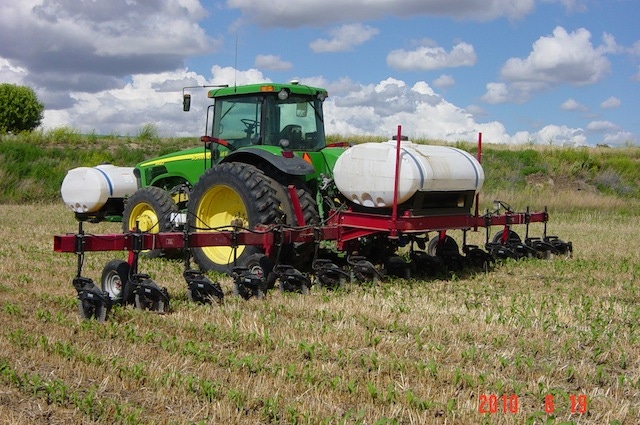February 1, 2013

For Jason Sheehan, cutting input costs was the main impetus for moving to variable-rate fertilizer application and N sidedressing. Reducing the potential for any off-site movement was a close second.
The Minnesota native relocated to the West a decade ago after marrying, and now operates a 3,000-cow dairy with wife Karen and her parents Tony and Brenda Veiga near Sunnyside, in southern Washington’s Yakima Valley. In recent years, concerns over nitrate levels in the area’s groundwater, from a variety of sources, led to the creation of a Groundwater Management Area (GWMA) in that part of the state.
Sheehan, who brings a Midwestern mindset to his work, serves on the Groundwater Advisory Committee, which was created by the GWMA to work collaboratively with stakeholders towards solutions. Area dairy farmers have taken the lead in this process by rethinking their crop nutrient and waste management strategies, with a focus on protecting the environment.
Three years ago, Sheehan enlisted the zone-mapping services of his local retailer, using the Simplot soil electrical conductivity technology to identify the natural soil variations across the 900 acres he farms. Triticale and corn are double-cropped, both for silage, with manure slurry irrigated on fields prior to planting each spring and fall.
“In the past, we had applied all our nitrogen fertilizer in the spring, prior to corn planting,” he says. “We spread urea and watered it in with irrigation. But three years ago, I invested in sidedressing and GPS equipment for variable-rate application, and in that first year cut my nitrogen bill in half.”
In 2009, prior to sidedressing, Sheehan spent about $70,000 on nitrogen (N). “Even though we were applying normal agronomic rates, it felt like we were putting on too much compared to our yield results.”
In 2010, he applied 30 lbs. of 32% liquid N before planting, then came back with two in-season sidedress N applications with sulfur and an N stabilizer. “The past two years I made just one in-season application to the corn, between the five- and six-leaf stages, and was really pleased with our yields.”
His application rig is fairly simple – Yetter coulters mounted on a 16-row toolbar, with two 525-gal. tanks. He has since gone from 30- to 22-in. row spacings. He uses a Trimble GPS system with real-time navigation. “The GPS system cost as much as the application equipment, but it was a great investment,” he notes.
In 2010, he spent about $35,000 on soil mapping, application equipment and the GPS system. “But in the first year, alone, we were able to save that same amount on the split application of nitrogen, which provided better crop placement.”
He also started using his GPS system with other field operations. “We use it for planting to control our starter fertilizer, and for spraying. Now that we’re using auto-steer, we wouldn’t go to the field without it,” he says. “It has allowed all my operators to be more efficient. When running the hay swather, for example, we can now cover 130-140 acres/day, compared to just 90-100 acres/day without auto-steer.”
Sheehan believes that soil mapping and spreading out his fertilizer applications has evened out the farm’s overall fertility. “We’re seeing less variation in nutrient levels now, and more even crop yields across fields.”
He says he also is more confident there is less chance of fertilizer moving off-target. “We’re doing a better job of giving the crop only what it needs, when it need it. It is better for our crops, and better for the environment.”
About the Author(s)
You May Also Like




